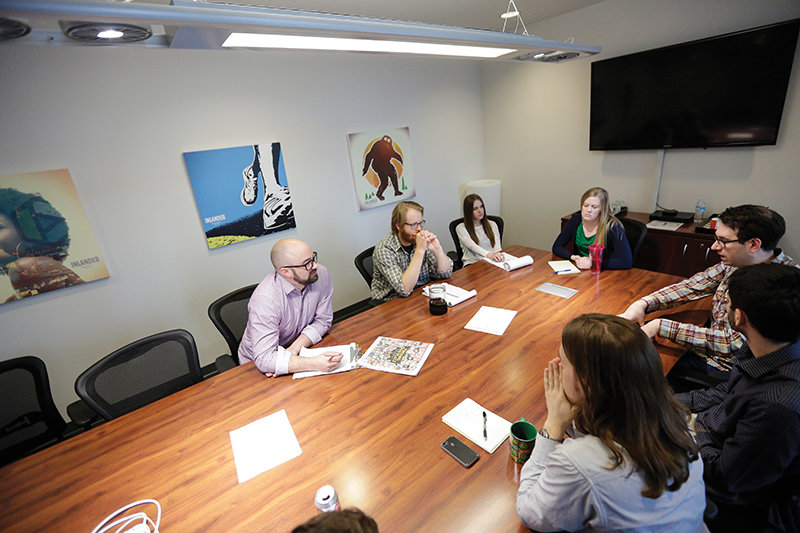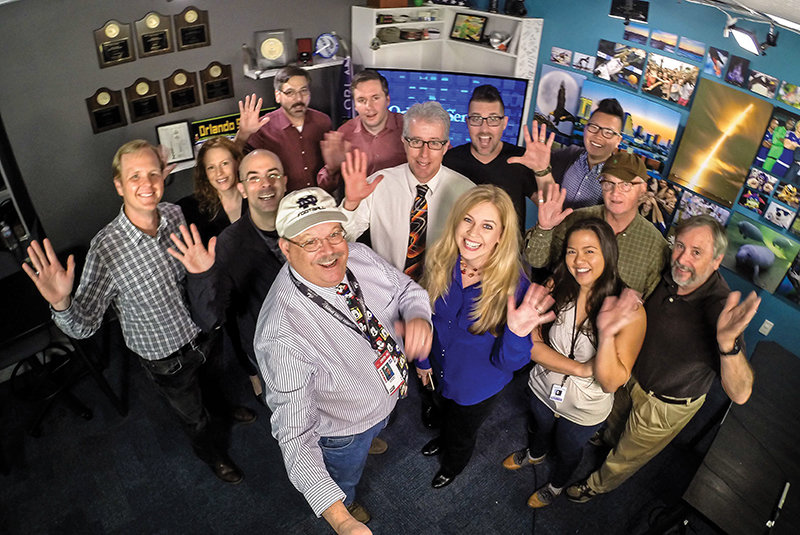 Illustration by Tony O. Champagne
Illustration by Tony O. Champagne
When we put out the call for nominations for our annual 10 Newspapers That Do It Right feature, we asked newspapers to send us their best ideas; in particular, we asked, “What was your most notable idea/project that helped the company find success?”
As you read through this year’s 10 newspapers and our list of honorable mentions, you will find plenty stories of success. Their ideas are diverse and inspirational: video and podcasting, niche websites, new print products, events, and more. What we hope is that their projects will add fuel to this industry that continues to press on.
 The Baltimore Sun team who worked on “The 45-Minute Mystery of Freddie Gray’s Death” include (from left) Catherine Rentz (seated), Adam Marton, Christopher T. Assaf, Amy Davis, Kevin Rector and Kenneth K. Lam. Not pictured Greg Kohn. (Photo by Lloyd Fox/Baltimore Sun)
The Baltimore Sun team who worked on “The 45-Minute Mystery of Freddie Gray’s Death” include (from left) Catherine Rentz (seated), Adam Marton, Christopher T. Assaf, Amy Davis, Kevin Rector and Kenneth K. Lam. Not pictured Greg Kohn. (Photo by Lloyd Fox/Baltimore Sun)
Baltimore Sun
Baltimore, Md.
Circulation: 253,333 Sunday; 132,414 daily
After the death of Freddie Gray, the 25-year-old African American man who died while in police custody last April, the Baltimore Sun sprang into action, sending out a team of investigative and visual reporters to the area where Gray had been arrested. The result of their investigation was an award-winning multimedia project called “The 45-Minute Mystery of Freddie Gray’s Death” and can be found at data.baltimoresun.com/freddie-gray. The series was posted six days after Gray’s death.
“That was the day of the first major riots,” said Trif Alatzas, senior vice president and executive editor of the Baltimore Sun Media Group. “We posted the slide show early. It was the only new piece of information out. We had the story no one else had. The reaction was intense. That continued into the weekend and the peaceful protests turned a little violent.”
The eight-person team produced interviews with eyewitnesses, showed previously unseen footage of the police van and discovered police video footage that had been erased. In order to produce the project, the Sun utilized its video and investigative reporting teams and the graphics department to “tell the story on different mediums,” said Alatzas.
“Our journalists spent each day comparing notes about the interviews, public documents, video and other images they were collecting,” he said. “Discussion centered on how to best tell the story through words and images.”
The slideshow timeline provided bite-sized information for people to easily follow. The six videos within the slides were kept short; none of them longer than three minutes. And for people who wanted more, the Sun also wrote a 2,200 word story published in print and online.
Alatzas attributed much of the story’s success and the swiftness in how they reported it to a police brutality database they had compiled early on.
The online project generated a combined 1.3 million page views and 560,000 unique visitors in 2015. For their dedicated reporting and innovative storytelling methods, the Sun received an Online News Association Award for explanatory reporting in September 2015 and a breaking news coverage award of the riots following Gray’s death.
Since the paper was competing with CNN and other major news networks, Alatzas said it was important for them to be the leading source of information, even after the TV crews left.
“(We decided) every day we’re going to have information no one else has,” he said. “It’s our responsibility to cover Baltimore better than anyone else.”
 C-VILLE Weekly publisher Aimee Atteberry (left) and editor Jessica Luck
C-VILLE Weekly publisher Aimee Atteberry (left) and editor Jessica Luck
C-VILLE Weekly
Charlottesville, Va.
Circulation: 23,000 weekly
In her 10 years at the C-VILLE Weekly, publisher Aimee Atteberry has seen her shares of ups and downs. Up: the publication celebrated its 25th anniversary in 2014 and saw double-digit growth over the previous year in profit. Down: In spring 2015, Atteberry lost four salespeople along with her editor. She called the transition one of the “hugest hurdles” she had ever faced.
Instead of scrambling to fill the vacant positions, Atteberry, who has been publisher for three years, took her time and hired a consultant to help find the best fits for the paper. “I knew revenue was going to suffer,” she said. “But we wanted to make the right choices.”
Atteberry’s patience paid off. She hired new salespeople, and this past summer, Jessica Luck joined the team as editor. Luck said she wasn’t nervous about coming into the shaky situation. She saw it as a “blank slate,” where she could try new ideas.
Several of them launched last year. One of them was C-VILLE Live, created as a way to engage with audiences through a live video. For the first episode, the Virginia Film Festival organizers were asked to participate.
“We invited the public to be part of the audience and also broadcast the interview live on Twitter through Periscope,” Atteberry said. “We also embedded the full video on our website for readers who were unable to join us for the live broadcasts.”
Future live episodes include coverage of events and festivals and roundtable interviews with readers as well as behind-the-scenes looks at C-VILLE Weekly.
Atteberry said multimedia was also a big focus for them. “We saw an eye-popping response from our readers in regard to several of our online initiatives and stories this year, which renewed our goal of producing print and Web content that not only speaks to each other but furthers the conversation between the two.”
One of those stories was “Barefoot Battle,” (c-ville.com/barefoot-battle), which included graphics, video and additional photos not found in print. According to Atteberry, the time spent on page for the article increased 300 percent above their average. In 2016, Atteberry wants to increase Web revenue by 100 percent and launch a weekly digital newsletter.
In addition to these new digital products, Atteberry launched two print magazines: Knife and Fork, focused on food and drink, and 434, a glossy annual lifestyle publication.
After two major years of ups and downs, Atteberry said 2016 will be the year of maintenance. “Keeping the growth we’ve had, maintaining our relationship and promoting our strong community partnerships,” she explained.
 Cannabist editor Ricardo Baca hosts a weekly video show with guests and a live audience. (Photo courtesy of The Denver Post)
Cannabist editor Ricardo Baca hosts a weekly video show with guests and a live audience. (Photo courtesy of The Denver Post)
Denver Post
Denver, Colo.
Circulation: 500,000 Sunday; 200,000 daily
The Denver Post’s marijuana website, The Cannabist (thecannabist.co), made national news when it launched in late 2013, right before Denver became the site of recreational marijuana’s first legal sale.
“The Denver Post took an interdepartmental approach to report on this transformation,” said director of newsroom operations Linda Shapley. “Post reporters, using multiplatform tools and techniques, chronicled the euphoric opening but then turned a watchdog’s eye toward regulation, sales, health, banking, pot barons, black markets, taxes, grow houses and addiction.”
Leading the website is former Post music critic and entertainment editor Ricardo Baca. As the Post’s first marijuana editor, Baca has taken on the role of investigator, moderator and explainer for a site that averages 1.8 million views monthly, said Shapley.
When Baca reflects on the last two years, he said the site has “grown up.” From a traffic standpoint, Baca said what does really well on the site is the hard news. “It’s the number one driver in traffic and that’s something we’re proud of,” he said.
According to Shapley, in 2015, Baca and investigative reporter David Migoya raised troubling questions about consumer safety over lax rules on pesticides used to grow marijuana. Starting with lab tests for pesticides commissioned by the Post, Migoya and Baca quickly exposed not only broad regulatory gaps, but also the internal politics and industry influence that allowed them to exist. Tests revealed the presence of unapproved pesticides at more than six times the permissible amount, and the results triggered 10 recalls over the next two months, involving thousands of products worth millions.
As a result, Shapley said, Colorado Gov. John Hickenlooper issued an executive order directing the state health department to consider all marijuana contaminated by unapproved pesticides “a risk to public health” and the revenue department to regard it as a “threat to public safety.”
Baca also credited the site’s popularity to the journalism-oriented pot criticism they post. “It’s legitimate writing that our critics take very seriously,” he said.
The Cannabist also launched a weekly video show and podcast, and hosted its inaugural business awards last year. Looking ahead, Baca said he plans to hire a general manager and more data journalists.
“The expertise that we’ve demonstrated in the cannabis culture is one that can be repeated in many different ways by all size of papers,” Shapley said. “Develop expertise in knowing everything about the largest industry in your town…The ability to create a niche product needs investment…but the return on that investment—both financially and in community engagement—will likely be great.”
 The Hutchinson News staff inside the Cosmosphere. (Photo by Nick Hemphill)
The Hutchinson News staff inside the Cosmosphere. (Photo by Nick Hemphill)
Hutchinson News
Hutchinson, Kan.
Circulation: 28,000 Sunday; 26,000 daily
In October, the Hutchinson News along with sister paper, The Garden City Telegram, launched a joint Sunday print edition. The Telegram, with a circulation of 4,500, previously only published Monday through Saturday, but readers wanted local coverage every day of the week.
Sara Bass, News marketing director and circulation operations manager, said, “The plan was for the Telegram to have a four-page cover section, in which they would provide news content and sell advertising. The Hutchinson News Sunday edition would be inserted inside…Since the launch, Sunday print home delivery for the News is up six percent year-over-year, the opt-out rate has been minimal, and both advertising and subscriber revenue has significantly increased for both papers.”
The News also expanded its digital presence by building several niche websites. Although Kansas is not known for earthquakes, publisher John Montgomery explained that due to the increase of fracking in the area, there have been more earthquakes. To provide residents with the most recent information, the paper created KansasQuakes.com, where residents can find a live map of events as soon as they’re recorded by the United State Geological Survey.
Also in 2015, the News created new digital sites within its own news site to showcase the Kansas State Fair and the Cosmosphere International SciED Center and Space Museum, both located in Hutchinson.
The state fair site features local weather reports, a live calendar of events and a history page, and Hutchnews.com/space features the paper’s continuing coverage of the Cosmosphere. It includes a chaptered documentary and interactive timeline about Apollo 13, a Kansas Space Hall of Fame and a space news station. Bass said the site is optimized for mobile and has brought in revenue through site sponsorships.
Montgomery said all of the new digital projects launched as a response to diversify and the work is done in-house . “Resources well spent,” he said.
The News also invested in Kansas Agland, its Web and print publication targeting the agricultural communities of western Kansas. The publication began in 2010, and in 2015, the News redesigned the website and added contributions from sister newspapers along with a podcast. According to Bass, the website started 2015 with more than 4,600 unique visitors and by September, it had grown to more than 21,000. The print publication is distributed to more than 27,000 households.
“All this reflected in revenue, which tripled in 2015 as Agland picked up advertisers from as far away as the northwestern corner of the state” Bass said. “Ad count more than doubled.”
 (Left to right) Inlander editor Jacob Fries, staff writer Jake Thomas, music editor Laura Johnson, listings editor Chey Scott, staff writer Mitch Ryals, staff writer Daniel Walters and staff writer Wilson Criscione in an editorial meeting.
(Left to right) Inlander editor Jacob Fries, staff writer Jake Thomas, music editor Laura Johnson, listings editor Chey Scott, staff writer Mitch Ryals, staff writer Daniel Walters and staff writer Wilson Criscione in an editorial meeting.
Inlander
Spokane, Wash.
Circulation: 50,000 weekly
To stay ahead, the Inlander is betting big on local partnerships and by operating with a start-up mentality. And how are they doing that? By working with experts to develop a video series, produce video games and launch community events.
“One way we have been able to grow is by expanding our financial footprint through partnerships with other businesses, enabling us to grow expertise while also limiting our exposure during times of experimentation,” said editor Jacob Fries. “Everything’s a test case Rather than investing wholeheartedly into new, untested areas…we are able to dip our toes into something new, and see how it fits with our mission and revenue goals.”
To do that, the Inlander partnered with local game developers and artists to build an online video game. Similar to the premise of the 1980s Atari game Paperboy, where players ride around suburban streets delivering newspapers, their version called Inlander Dude was designed with local businesses, streets and addresses built into it, giving players a deeper connection to the game.
The paper also partnered with local filmmakers to create a pilot episode for a cooking show which brings in local chefs to demonstrate cooking fun and creative meals. The episode gave advertisers a taste before filming an entire series, which Fries said they will launch soon. Additional episodes are already in development.
For the last five years, the Inlander has also worked with a local music producer to put on the Volume music festival. The festival has generated $40,000 in revenue and averages close to 3,000 attendees. The Inlander also works with local restaurants to put on a restaurant week for patrons. More than 100 restaurants participated in the most recent one. During the week, the Inlander also puts out an event guide with special menus.
Fries said experimentation can come at a cost, but to be successful, it’s important for newspapers to take risks.
“Ultimately, utilizing a start-up mentality has forced us to question everything, rather than simply allowing momentum and we-have-always-done-it-this-way thinking to win the day,” he said.
News-Gazette
Champaign, Ill.
Circulation: 32,000 Sunday; 29,000 daily
The News-Gazette has singer Paul Simon to thank for the inspiration behind their “50 Ways to Engage Our Readers” project. Created as a play off Simon’s, “50 Ways to Leave Your Lover,” editor Jim Rossow said their spin on the song’s title reconnects the paper with its customers.
The idea began in 2013 when Rossow became editor. With the assistance of his new managing editor Jeff D’Alessio, the two of them sat down to figure out how they could do things differently in the newsroom. Their conclusion: It all came down to the audience.
“Gone are the days where the audience is coming to us,” Rossow said. “We had to find ways to them.”
And they originally found 200 of them.
Their condensed list of 50 displays the creative thinking found in their newsroom. Columnist Tom Kacich, who has been with the paper for 40 years, pitched an idea called “Tom’s Mailbag,” where he answered a week’s worth of reader-submitted questions every Friday online. Photo editor John Dixon came up with the idea to use a drone to produce video stories and photography. Rossow’s office was converted into a studio, where in-house videos and podcasts are produced and as a way to connect to the company’s three radio stations. In the future, Rossow wants to experiment with livestreaming.
A complete newsroom reorganization was also on the list. According to Rossow, to promote a team concept, an open floor newsroom was created. Three 60-inch TV screens were erected on the main wall to reveal real-time analytics and social media activity.
Rossow said they found having the live data right there was an “inspiration” to some of the employees. “It spurred them into action when they could walk by and see what stories or videos were more popular.” As a result, online growth has grown tremendously. Rossow reported there was a 30 percent increase in page views from 2014 to 2015.
The News-Gazette also created a video (bit.ly/1hhGRq4) outlining the project’s success, which they show to community members whenever possible. But Rossow admits not everything on the list was a hit (for example, a video letter to the editor didn’t take off after letter writers visited their studio and saw themselves on camera for the first time).
“(This project) taught us we have an unlimited audience in all shapes and sizes,” he said. “And the more we offer, the more they pay attention.”
So, what’s next for the paper? “50 Ways to Engage Our Advertisers,” said Rossow.
 The Orlando Sentinel video team
The Orlando Sentinel video team
Orlando Sentinel
Orlando, Fla.
Circulation: 191,000 Sunday; 91,000 daily
After a companywide reorganization in 2014, Orlando Sentinel interactive and visuals manager Todd Stewart thought it was time for the newspaper to dive deeper into video. That’s when the company decided to make radical changes to the department. Without eliminating any jobs, Stewart said they became “video first.” They equipped their videographers with mobile video kits, which include an iPad, a tripod and a microphone to capture breaking news and to make it easier to upload to the news site immediately.
“The first few months were a little bumpy, but we learned and grew along the way,” said Stewart.
That growth resulted in a 95 percent increase in video views year-over-year. They now upload about 10 to 15 videos each day and produce a webcast with the local Fox affiliate TV station called “Orlando News Now.” The five-day-a-week webcast shares stories from the paper, interviewing reporters and guests while covering daily news topics.
Building on that success, the Sentinel also invested in live backpack equipment, which allows the paper to compete with local television stations covering events such as press conferences and NBA games. The backpack is the same one used by TV stations, said Stewart.
“(We’re) among the very first newspaper companies to own one…We were immediately beating TV at its own game,” he said. “Some people are surprised to see the Orlando Sentinel doing what we’re doing. We’re opening some eyes. They’re live at 5 o’clock, but we’re live online now.”
By producing more videos, Stewart said the Sentinel has been able to sell more pre-roll video ads, which produce the highest CPMs for the newspaper.
As part of the companywide effort to invest in video, Stewart said they also taught reporters the basics of video filming and editing. Reporters were trained on how to use the mobile video kits in the case one of the Sentinel’s 15 visual team members couldn’t make it to the scene.
Stewart said the best way to succeed in video is to encourage videographers to tell more innovative and interesting stories, and to lean on video natives to guide newsrooms to low cost/high return equipment and resources instead of purchasing unnecessary, expensive cameras.
“It’s been a culture change in the newsroom,” Stewart said. “The reason we did so much was because we had a leader who believes in digital journalism, that we can live and thrive in that world.”
 Revolution 2015 team leaders (from left to right): Carolyn Voelkening, Anthony Calderaro, Shawn Palmer, Liz White (chairperson), Dave Pare, Andrew Burris and Ralph Tomaselli
Revolution 2015 team leaders (from left to right): Carolyn Voelkening, Anthony Calderaro, Shawn Palmer, Liz White (chairperson), Dave Pare, Andrew Burris and Ralph Tomaselli
Record-Journal
Meriden, Conn.
Circulation: 42,500 Sunday and daily
Last year, the Record-Journal took steps to ignite a movement throughout the company by launching Revolution 2015. The goal was to revamp and improve best digital practices, increase digital audience growth and digital revenue by 20 percent, and utilize a new building to develop a line of communication to best serve the newspaper.
In order to meet these goals, Elizabeth White, executive vice president and assistant publisher, said they divided into six teams and areas of focus: content, monetizing growth, building subscriptions, building audience, design and marketing, and support services.
“Revolution 2015 was an opportunity for us to communicate to everyone in our company what the most important goals were,” she said.
To grow digital audience, White said they focused on how to best use social media to build audience. They did this by posting more frequently and strategically to draw page views and unique views on the site. This resulted in an increase in digital audience by 39 percent, 1.8 million digital monthly page views and 280,000 monthly unique visitors.
The Record-Journal also increased digital revenue by 32 percent year-over-year by “grabbing low-hanging fruit,” White said. They increased banner ad revenue, moved toward programmatic ads and increased content revenue.
In addition, Revolution 2015 helped the Record-Journal increase digital subscriptions by 11 percent, and digital activations, where print subscribers activate the bundled digital package, grew by 31 percent.
White said another large part of their success was due to moving their office to a new location. “The way the new office is set up facilitates a culture of collaboration. We’re all on one floor and all departments can see each other. There are meeting and social areas. It was a huge part of helping Revolution 2015 become successful.”
White said they’re already thinking about how to continue their revolution in 2016. Although there won’t be any teams this year, they plan to focus on one initiative each quarter as an entire company. Some of their goals include finding solutions and best practices for native advertising, video and mobile.
StarNews
Wilmington, N.C.
Circulation: 36,000 Sunday; 32,600 daily
Some publications might take the news of being sold for the second time in two years with trepidation, but not the StarNews. In fact, they were giddy, said executive editor Pam Sander.
While the transition from Halifax Media, a traditionally print minded company, to GateHouse Media, a company known for its digital initiatives, was jarring, the sale opened up opportunities for the small newspaper to become a bona fide digital first publication.
In 2015, the paper shifted its budget priorities to focus on digital. Sander said, “We went from afternoon meetings, where we would plan the next day’s print issue to having morning meetings for the Web that day.”
Becoming truly digital first required the staff to start putting as much emphasis on their website, starnewsonline.com, as they did their A1 page. They also had to focus on creating new ways to find their digital audience.
Facebook, for example, has become “like the old neighbor’s print section,” Sander said, where hyper-local content is shared. Pinterest is used to share recipes and other lifestyle content, which has resulted in a 200 percent increase in referrals on the platform. Social media referrals have increased five percent daily month-over-month.
The paper’s digital initiatives also helped them remain true to their mission of being community minded. They developed shareable programs centered on community interests and audience involvement. These include contests, voting on photos of the month, polls and quizzes.
The newspaper also utilizes its own archives as a way to build audiences. Strategies, such as #tbt photos and a section on the homepage called StarNews Flashback, where old news stories and advertisements are shared, are among the site’s most popular features.
The StarNews also added two sections for readers on the website. Facilitated by the paper’s community editor, Your Voice is a section that allows readers to cover events, and MyReporter.com, allows readers to ask a reporter direct questions about past articles, local ongoings, and share stories or tips. It averages 80,000 to 100,000 page views per month.
But the StarNews hasn’t forgotten about print. In late 2014, the paper made $65,000 in revenue through a special section surrounding Wilmington’s 275th anniversary. In 2015, the newsroom and circulation department produced five premium print sections, bringing in $200,000. Accompanying Web components included quizzes, databases, travel maps and a bingo game to increase reader participation.
 (From left) Kevin Kluender, assistant athletic director, marketing and promotions, University of Wisconsin Athletics; Katie Lundgren-Smith, assistant director, marketing and promotions, University of Wisconsin Athletics; Zach Wagner, general manager, Badger Sports Properties; John Humenik, president and publisher, Wisconsin State Journal; and Joe Allen, vice president of advertising, sales and marketing, Capital Newspapers.
(From left) Kevin Kluender, assistant athletic director, marketing and promotions, University of Wisconsin Athletics; Katie Lundgren-Smith, assistant director, marketing and promotions, University of Wisconsin Athletics; Zach Wagner, general manager, Badger Sports Properties; John Humenik, president and publisher, Wisconsin State Journal; and Joe Allen, vice president of advertising, sales and marketing, Capital Newspapers.
Wisconsin State Journal
Madison, Wis.
Circulation: 92,421 Sunday; 71,347 daily
When the Wisconsin State Journal and the University of Wisconsin Athletic Department chose to work together on a collaborative content and marketing initiative, publisher John Humenik had to wonder, “Why did we never network before?”
Talks between the two organizations in the popular college town started about a year ago, and now their “In the Arena” project is entering its second season.
Here’s how it works, according to Humenik: “The university’s athletic department creates content independent of the newspaper that is then displayed in the State Journal and on Madison.com. The content, which comes in the form of front page spadeas, strip ads and double trucks, engages readers in many facets of the athletic department, including information about major and minor sports teams, ticket information, annual report on the department’s finances, and a spotlight on academics and graduating senior athletes. The digital content focuses on driving ticket sales.”
And what does the paper receive? Humenik said the State Journal and its photographers create content that enhances the game day experience for fans in the UW football stadium and the basketball arena. Action photos shot during play are displayed on the main scoreboards under the segment “Images of Game Day.” Additionally, the State Journal has adjacencies to “Live Look-in” video coverage of other games in progress during a Wisconsin game.
“I think one of the driving factors in this positive relationship is that both parties are invested in each other’s success,” Kevin Kluender, UW assistant athletic director/marketing and promotions, stated in a support letter. “(The State Journal) has certainly helped us expand our reach and communicate our initiatives (and) we believe we have been able to offer (the State Journal) unique ways to reach our event attendees.”
Humenik stressed that the newspaper’s sports staff is not involved with the marketing arrangement. The emphasis, he said, is to bring together ideas with the university while learning from each other.
“Together, the two organizations bolster a sense of place and a sense of pride in one of America’s great college towns,” Humenik said. “Moreover, they demonstrate how relationship-building and collaboration help build community.”
Honorable Mentions
The E&P staff would like to thank each paper that sent us a submission this year for 10 Newspapers That Do It Right. As we read through the entries, we were impressed by the quality of work being done at publications around the world. Every year, it’s a challenge for us to narrow the list down to just 10 papers, but we still want to recognize the ones that didn’t quite make the final cut this time for a job well done.
Albuquerque Journal
Albuquerque, N.M.
The Albuquerque Journal collected usage and behavioral data from subscribers and funneled that information and activity into one central database. From that, one of the paper’s most successful engagement initiatives was created: the Journal Rewards mobile app. The program has improved customer retention among those engaged with the program. Since its launch in January 2015, the paper has seen a 15 percent lift in subscriber retention.
Amador Ledger Dispatch
Jackson, Calif.
When the Butte Mountain Fire started in Amador County, the Amador Ledger Dispatch team swung into action utilizing their print and digital services. A special Butte Mountain Fire edition ran in September 2015, covering the entire timeline of events. A Hometown Heroes edition featured stories of courage, bravery and giving in the recovery efforts. The paper also put out a video of a flight over the damaged counties. News on the fire trended on Facebook and garnered an audience of more than 2.5 million for over two weeks.
Batavia Daily News
Batavia, N.Y.
In 2015, the Batavia Daily News pledged to “Do More, Do It Better, and Do It All…Faster!” The paper switched over to a new CMS and ad production system, changed the design of the print edition and website, and switched from an afternoon paper to a morning paper. As a result, the paper saw a 30.1 percent increase YOY in ROP sales, 67.8 increased in digital sales YOY, and overall expense lowered 4.9 percent, while overall profit increased YOY of 319.2 percent.
Daily Press
Newport News, Va.
Beginning in 2014 with an eight-part series “The Virginia Way: Politics, Power and Profit,” the Daily Press set out to make clear to its readers just how easy it was for lawmakers to game the system and how difficult it could be to shine a light on their activities. Last fall, the paper organized a statewide Freedom of Information Act project.
Journal Star
Peoria, Ill.
As violence grew in the city’s south end, Robin Berry, the housing development director for Peoria Citizens Committee for Economic Opportunity and an active member of the Journal Star’s reader advisory group, contacted executive editor Dennis Anderson, the leader of the readership group, to say a neighborhood cleanup project was going to take place. The Journal Star wrote a story published the day of the event addressing the concerns about violence and safety. In the end, Berry reported full participation and a successful community cleanup.
Petoskey News-Review
Petoskey, Mich.
The Petoskey News-Review split up the newsroom into digital-focused reporters and print-focused reporters. Each digital reporter produces a daily video, weekly podcast, weekly photo gallery, rewrite stories for digital, use social media to promote stories, and update the website. They are also expected to create at least one new digital feature a quarter. So far, they have created 360 degree photos, live streaming through mobile apps, and interactive graphics.
Post and Courier
Charleston, S.C.
The Post and Courier decided to promote existing content to non-subscribers by installing 47 RedPost “smart” digital displays at its top-selling single copy locations. A device inside the displays calculates the number of people in viewing range every minute of every day. On average, more than 20,000 people saw one of the new displays each day.
Record Searchlight
Redding, Calif.
In February 2015, the Record Searchlight launched the 530 Media Project, a community outreach effort to teach residents how to use social media and other digital communication tools. The paper led 14 free workshops, and in all, 313 people attended one or more of the workshops in 2015. Nearly 100 people have signed up for seven workshops announced for the first quarter of 2016.
Sanford Herald
Sanford, N.C.
The Sanford Herald decided to “introduce” the sales staff to the community through a house ad that ran each week, showing a photo of each sales rep and their contact info. Sales reps became “mini-celebrities” around town, boosting their confidence, which translated into more sales. The paper recently won a “New Business Sales Contest,” competing with 10 other newspapers in its group, bringing in the most new business in a 90 day period.
Sarasota Herald-Tribune
Sarasota, Fla.
In 2015, the Sarasota Herald-Tribune launched Unravel, a mobile-first, local-focused solution created to engage with the millennial audience. The team is made up of young professionals in the Herald-Tribune newsroom, pulling together data and conducting behavior-based interviews.
State Journal-Register
Springfield, Ill.
The State Journal-Register created deep connections with its readers in several key areas: hosting forums and debates; reaching out to a younger audience through its teen section; bettering the community and recognizing good works; amplifying community voices through a reader advisory board and other partnerships; engaging with audiences through radio and TV stations and online chats; and Impressions, a rental and events arm of the company, where more than 3,000 people have attended events at the paper’s three venues.
Comments
No comments on this item Please log in to comment by clicking here